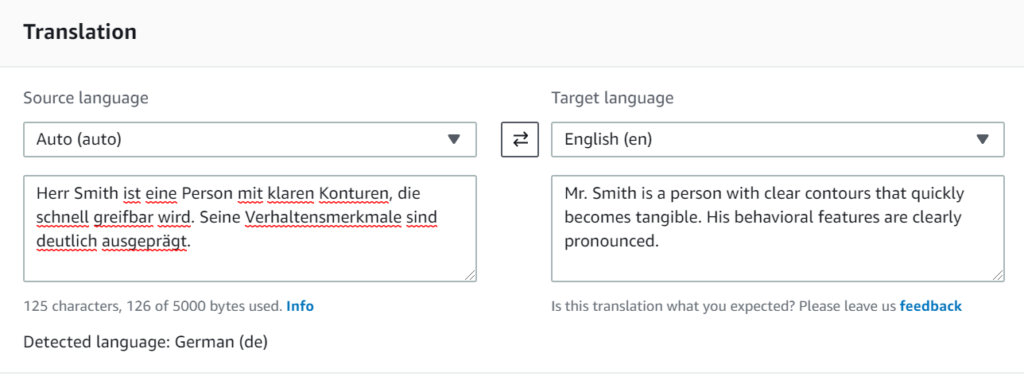A few weeks ago I wrote a post on LinkedIn entitled: More proof why IMO machine translation is clearly not ready to replace professional translators. You can see the full post here.
This was a simple test that we ran after receiving an order from one of our clients. We ran the original German sentence through a number of free online machine translation tools and compared the results against our own translation. Our translation was done by our professional team without using any MT software.
The results were conclusive and all of the MTs botched up the translation. Now, we fed the original sentence into Amazon Translate, another NMT which is nowhere near as well-known as Google Translate.

Original sentence in German:
Herr Smith ist eine Person mit klaren Konturen, die schnell greifbar wird. Seine Verhaltensmerkmale sind deutlich ausgeprägt.
Amazon Translate result:
Mr. Smith is a person with clear contours that quickly becomes tangible. His behavioral features are clearly pronounced.
Human Translation:
Mr. Smith is somebody with a clear sense of purpose who is readily available. His behavioral characteristics are very distinct.
Here too the results are conclusive and Amazon botched up the translation as well. Which is a bit surprising since in his introductory video from 2018, Amazon’s Yoni Friedman states the following:
… over the last year we had productized (sic) proprietary state-of-the-art neural machine translation engines and that was a leap ahead for us in terms of quality …. in essence statistical engines which are the ones that we used to have are basically a fancy lookup algorithm that makes decisions based on the probability of a certain word mapping in the source language mapping to the word to a different word in the target language. The problem with these statistical models is that predominantly they don’t understand context …. but that’s no longer the case with neural engines. …. generally speaking neural engines are built such that they mimic the way they’re inspired by the way that the human brain learns and processes information and that means a ton in terms of performance they understand quality and they understand context they understand the focus of the sentence and they understand morphology.
You can watch the entire presentation here:
If the Amazon NMT mimics the human brain and can understand context within a sentence, then why did it fail our translation test? If NMT understands context, then how did it translate the word Konturen as contours. Clearly this out of context.
The bottom line is that NMT, with all of its advances, is still not ready to replace professional translators. And any use of NMT in a professional environment will need close post-editing.
Amazon Translate is based on technology that was acquired by Amazon in 2015 when it acquired CMU’s Safaba.





